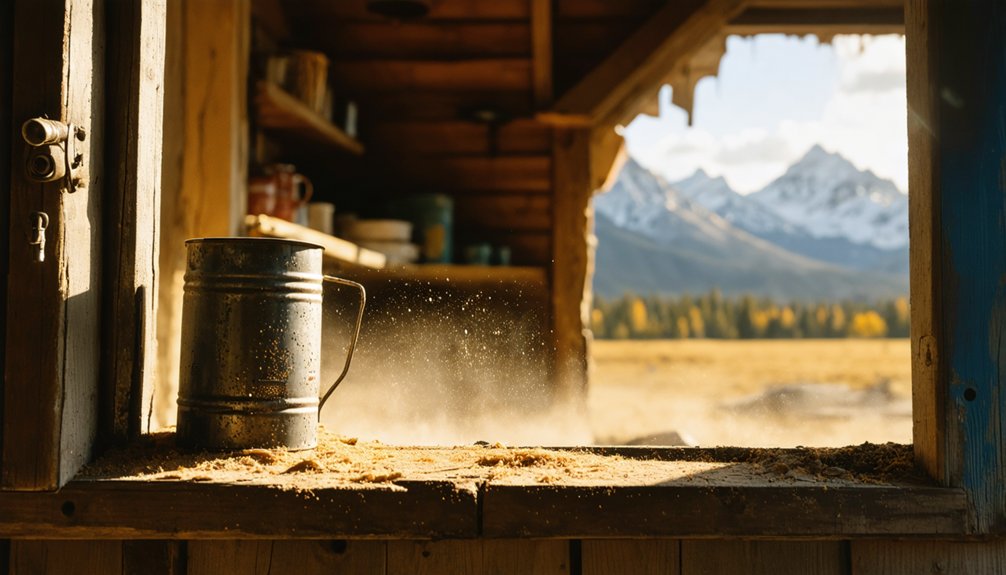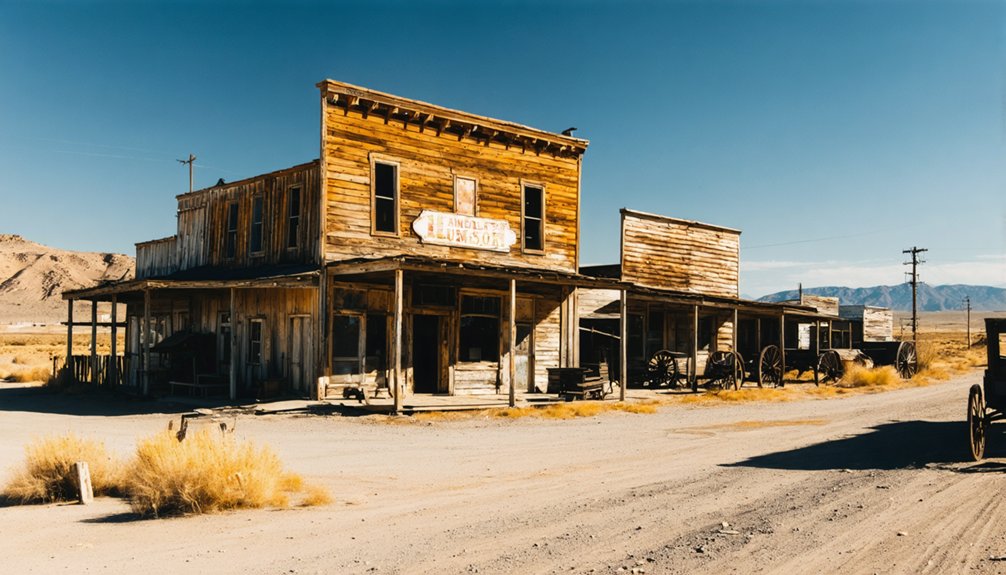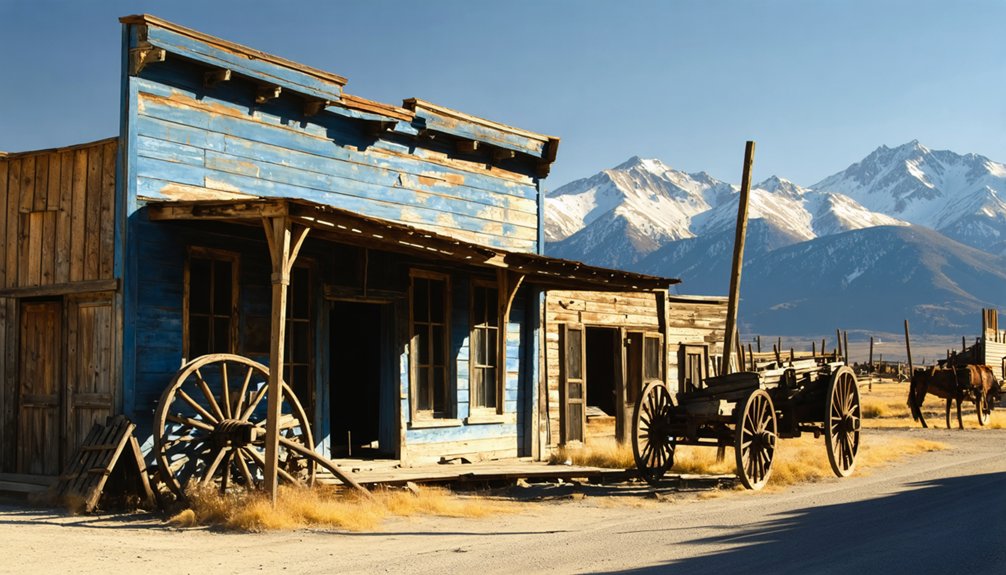You’ll discover America’s most authentic ghost towns across the western states, where preserved structures tell vivid tales of the 19th-century mineral rushes. California’s Bodie State Historic Park, Nevada’s Virginia City, and Montana’s Bannack showcase original Gold Rush architecture and mining heritage. Other must-visit destinations include Alaska’s Kennecott Copper Mine, Arizona’s Jerome and Oatman, Wyoming’s South Pass City, and Idaho’s Silver City. These remarkable sites offer guided tours, historic buildings, and immersive experiences that transport you deep into the untamed frontier spirit.
Key Takeaways
- Bodie State Historic Park in California offers America’s most authentic Gold Rush experience with over 100 original structures in “arrested decay.”
- Virginia City, Nevada features 400 preserved Victorian buildings, historic mine tours, and the famous Piper’s Opera House from the Comstock era.
- Calico Ghost Town showcases silver mining history through self-guided mine tours, railroad rides, and five original buildings on Main Street.
- Bannack, Montana preserves 60 historic structures from 1862, including the territorial capitol, offering gold panning activities and guided tours.
- Jerome, Arizona combines mining heritage with modern artistic culture at 5,000 feet elevation, featuring the United Verde Mine and creative residents.
Bodie State Historic Park: California’s Best-Preserved Mining Town
Nestled in California’s rugged eastern Sierra, Bodie State Historic Park stands as America’s most authentic ghost town from the Gold Rush era.
What began as a small mining camp after William S. Bodey’s 1859 gold discovery transformed into a bustling boomtown of 10,000 residents by 1879.
Today, you’ll find over 100 original structures frozen in time, maintained in “arrested decay” since the last residents departed in 1942. Visitors can take a guided stamp mill tour to see where gold ore was processed.
As California’s official gold rush ghost town and a National Historic Landmark, Bodie history comes alive as you explore deserted streets lined with fully-stocked buildings, preserved exactly as their inhabitants left them.
The town’s notorious reputation was earned through its mile-long Main Street filled with 65 saloons and a thriving red light district.
You can examine authentic mining equipment, peek into the historic Boone Store, and visit the atmospheric cemetery – all while experiencing the raw freedom of the American West.
The Silver Legacy of Virginia City, Nevada
You’ll find remarkable evidence of Virginia City’s silver mining wealth in its preserved Victorian architecture and historic mine sites from the 1859 Comstock Lode discovery.
The city’s most profitable mines, including the Consolidated Virginia and California mines, generated an astounding $3 million monthly during peak production years, leaving behind impressive industrial remnants you can tour today. Today, visitors can explore the historic Ponderosa Saloon to learn fascinating mining trivia and history.
Walking through Virginia City’s downtown district, you can explore original buildings that showcase the town’s transformation from a small settlement into a bustling metropolis of 25,000 residents during America’s richest silver strike. A devastating fire in 1870s caused $10 million in damage, but many historic structures were rebuilt and still stand today.
Mining Riches Still Visible
Deep beneath Virginia City’s historic streets lies one of America’s most significant mineral discoveries – the Comstock Lode, which yielded over $400 million in gold and silver after its discovery in 1859.
You can still explore this remarkable legacy today through guided tours of the Chollar Mine, where you’ll walk 400 feet into original mining tunnels and witness historic mining techniques firsthand.
The city’s immense wealth made it one of the wealthiest U.S. cities during its 1870s peak.
The Nevada Mill, constructed in 1887, stands as a symbol of the industrial scale of ore processing during the boom years.
Throughout the landscape, you’ll find over 100 mines, their headframes rising like sentinels above the desert terrain.
Many of these sites are rumored to harbor ghost stories from the mining era, while active operations like the Lucerne Mine continue to extract precious metals, proving the Comstock’s enduring wealth.
From its peak population of 25,000 residents, the town has dwindled to around 800 people today, yet maintains its historic charm.
Historic Buildings Worth Exploring
Standing as a proof of the Comstock Lode’s incredible wealth, Virginia City’s historic district showcases over 400 nineteenth-century buildings that transport visitors back to America’s silver mining heyday.
The town’s historic preservation efforts have maintained authentic wooden sidewalks and period-correct façades that you’ll experience while exploring this architectural time capsule. Located 40 minutes southeast from Reno, this paranormal hotspot draws visitors year-round.
- Piper’s Opera House stands as a cultural significance landmark, where you can walk the same halls that once hosted theatrical performances during the mining boom.
- The Gold Hill Hotel, dating to the mid-1800s, lets you stay where Mark Twain once roamed.
- St. Mary in the Mountains Catholic Church’s prominent spire dominates the skyline, offering a striking example of Victorian-era religious architecture.
The district’s brick buildings, most two to three stories tall, continue serving as active businesses, maintaining their historic character while engaging modern visitors.
Bannack: Montana’s First Territorial Capital
Following a major gold discovery at Grasshopper Creek in 1862, Bannack rapidly emerged as Montana’s first territorial capital, marking a pivotal moment in the region’s development.
You’ll find a town that once bustled with 3,000 residents during the mining boom, though its territorial status lasted just one year before moving to Virginia City in 1865.
While exploring this preserved ghost town, you’ll encounter about 60 historic structures that tell tales of frontier justice and the infamous Sheriff Henry Plummer, who led an outlaw gang called the Innocents.
The Vigilance Committee members took matters into their own hands in December 1863, executing twenty-two men in their quest to restore order to the lawless territory.
Today, as a State Park, Bannack offers you an authentic glimpse into the Old West through guided tours, gold panning activities, and seasonal events.
The wooden sidewalks, historic buildings, and surrounding landscape create an immersive experience of Montana’s rich territorial heritage.
Visitors can explore the historic Hotel Meade, which transformed from a courthouse into a hotel in 1891.
Kennecott’s Copper Empire in Alaska’s Wilderness
In Alaska’s rugged wilderness, the Kennecott Copper Mine emerged as one of America’s most remarkable mining ventures after prospectors Clarence Warren and Jack Smith discovered an exceptionally rich copper deposit near the Kennicott Glacier in the early 1900s.
This copper mining empire, backed by the powerful Alaska Syndicate, transformed the remote landscape with a 196-mile railway and a self-contained community. The mine’s development required an unprecedented investment of $25 million from 1905 to 1911, equivalent to over $730 million today. From 1911 to 1938, you’ll find the historical significance of Kennecott in its staggering production of 4.6 million tons of ore valued at $200 million.
- Tour preserved buildings including the mill, general store, and railroad depot
- Experience the grandeur of America’s largest national park, Wrangell-St. Elias
- Explore the remnants of a thriving community that once housed 600 workers
Today, as a National Historic Landmark, you can walk through this monument to American industrial might.
Garnet: Montana’s Hidden Mountain Treasure

You’ll find Garnet’s remarkable collection of original structures from the 1890s gold rush era, including saloons, hotels, and a schoolhouse, still standing at 6,000 feet in Montana’s rugged mountains.
While spring through fall offers the most reliable access to this historic mining town, winter visits require special planning due to heavy snowfall and limited road maintenance.
As Montana’s best-preserved ghost town, Garnet showcases the legacy of its mining heyday when nearly 1,000 residents pursued gold-bearing quartz in the surrounding peaks before the town’s eventual abandonment in the 1940s.
Historical Buildings Still Standing
Perched among Montana’s rugged mountains, Garnet stands as one of the state’s best-preserved ghost towns, with approximately 30 original structures still standing from its 1890s gold mining heyday.
The ghost town architecture reflects the rapid construction of the era, with wooden buildings erected without foundations to serve the bustling mining community of 1,000 residents. Through historical preservation efforts by the BLM and Garnet Preservation Association, these structures remain in arrested decay.
- The three-story hotel anchors the townsite, alongside preserved saloons, stores, and a doctor’s office.
- Many buildings retain original furnishings, from old bicycles to sewing machines.
- The Dahl House, built in 1938, served as both residence and speakeasy during Prohibition.
You’ll find authentic remnants of frontier life throughout these weathered yet enduring structures, protected as a National Historic Place since 2010.
Getting There Year Round
Several well-maintained routes lead visitors to Garnet Ghost Town, with the primary access from Montana Route 200 offering the most reliable year-round passage.
You’ll find this route about 30 miles east of Missoula, where Garnet Range Road branches south between mile markers 22-23, leading 11 miles to the parking area.
Year-round accessibility varies considerably with the seasons. While summer offers straightforward travel for most vehicles, spring conditions can present muddy challenges, particularly in May.
Winter demands extra preparation, though the visitor center maintains limited weekend hours. Vehicle considerations are essential – stick to passenger vehicles on the main route, as alternative access roads aren’t suitable for RVs or trailers.
The site’s 6,000-foot elevation means weather can change rapidly, so plan accordingly with supplies and appropriate transportation.
Gold Rush Mining Legacy
The gold rush history of Garnet traces back to the mid-1860s, when fortune seekers migrated north from depleted mines in California and Colorado. Initially focused on placer mining technology, prospectors washed gold from sand and gravel until those deposits were exhausted by 1870.
The economic impact shifted dramatically when Samuel Ritchie struck a rich ore body in the Nancy Hanks mine in 1895, triggering a major rush that transformed the area.
- Dr. Mitchell’s stamp mill establishment revolutionized local ore processing
- Mining consolidation in the 1890s drove population growth and business diversity
- Roosevelt’s 1934 gold price increase briefly revived the town’s fortunes
This boom-and-bust cycle exemplifies the volatile nature of mining communities, with Garnet ultimately yielding millions in gold before World War II restrictions effectively ended large-scale operations.
Calico Ghost Town: Southern California’s Mining Heritage

Located in Southern California’s Mojave Desert, Calico Ghost Town stands as a tribute to the region’s rich silver mining heritage since its founding in 1881. During its peak, over 500 mines produced $20 million in silver ore before the town’s abandonment in the mid-1890s.
Abandoned in the 1890s, Calico’s mines once yielded $20 million in silver, making it a crown jewel of California’s mining era.
You’ll discover authentic mining techniques through the self-guided Maggie Mine Tour, which showcases original equipment and underground passages.
Thanks to Walter Knott’s ghost town preservation efforts in the 1950s, you can explore five original buildings and numerous historically accurate reconstructions along Main Street.
Now managed by San Bernardino County, Calico offers immersive experiences including narrow-gauge railroad rides, gold panning, and educational tours.
As California’s official Silver Rush Ghost Town, it provides a compelling glimpse into the boom-and-bust cycle of Western mining communities.
Jerome: Arizona’s Vertical Mining City
Perched dramatically at 5,000 feet on Cleopatra Hill’s steep slopes, Jerome stands as one of Arizona’s most distinctive mining ghost towns. The town’s vertical architecture reflects its unique development, with buildings stacked precariously on the mountainside, many frozen mid-slide due to mining-related ground instability.
During its heyday, Jerome’s mining history yielded 33 million tons of copper, gold, and silver, supporting a diverse population of 15,000 residents.
- You’ll discover a town transformed from its mining roots into an artistic haven of 450 creative residents.
- The United Verde Mine’s 4,200-foot-deep shafts and 300-foot open pit showcase industrial scale mining.
- You can explore the town’s paranormal reputation through ghost tours and historic walks.
Today, Jerome balances its authentic ghost town character with vibrant galleries, boutiques, and cultural attractions.
South Pass City: Wyoming’s Gold Rush Legacy

Following a modest 1842 gold discovery by California-bound travelers, South Pass City emerged as Wyoming’s premier gold rush settlement when Fort Bridger soldiers staked the first official claim in 1867.
By 1868, the town’s population swelled to 5,000, with nearby settlements bringing the total to 12,000 residents seeking fortune.
You’ll find evidence of innovative mining technology in the preserved Carissa Mine, which produced over $1 million in gold using 26-stamp mills and arrastres to crush ore.
The half-mile main street showcases authentic period buildings, from saloons to general stores, making it one of the West’s best-preserved mining towns.
During July’s Gold Rush Days, you can pan for real gold, watch historic reenactments, and tour the mines that once drew thousands to this rugged frontier outpost.
Oatman: Arizona’s Wild Burro Paradise
You’ll encounter wild burros freely roaming the streets when you visit Oatman, a former gold mining town that flourished in the early 1900s and now stands as one of Arizona’s most distinctive ghost towns along Historic Route 66.
These burros, descendants of pack animals abandoned by miners, have become the town’s main attraction, drawing tourists who can feed and photograph the protected animals against a backdrop of authentic Old West architecture.
The combination of Oatman’s gold mining heritage, its location on America’s historic “Mother Road,” and its resident wild burro population creates a unique Western experience that sets it apart from other ghost town destinations.
Wild Burros Roam Free
Deep in the heart of northwest Arizona, wild burros freely roam the historic streets of Oatman, where a thriving population of over 6,000 comprises the state’s largest concentration of these desert-dwelling equines.
You’ll witness fascinating burro behavior as these untamed creatures navigate through town, led by Oliver, the alpha male who guides his herd of 13. Tourist interactions are carefully managed to protect both visitors and burros, with designated feeding areas where you can offer compressed hay cubes sold by local merchants.
- Black Mountain herd spans 1.1 million acres from Lake Havasu City to Hoover Dam
- Burros maintain their wild instincts while displaying playful, vocal behaviors
- Despite habituation to humans, they exhibit natural territorial and herd dynamics
These living symbols of the American West continue to shape Oatman’s identity, preserving its authentic frontier spirit.
Historic Route 66 Stop
As travelers ascend the winding switchbacks of Historic Route 66 through Arizona’s Black Mountains, Oatman emerges as a tribute to America’s golden age of highway travel.
You’ll climb over 2,100 feet across eight challenging miles, conquering hairpin turns before reaching Sitgreaves Pass at 3,595 feet. This rugged stretch showcases dramatic desert vistas, Joshua trees, and distinctive formations like Elephant’s Tooth Mountain.
Among Oatman attractions, you’ll discover preserved wooden buildings and boardwalks that transport you to the early 1900s.
The historic Oatman Hotel anchors the town’s authentic Route 66 history, while daily gunfight reenactments by the Ghost Rider Gunfighters bring the Wild West to life.
The Glory Hole Soda Fountain and Cool Springs stand as evidence of the era when Route 66 reigned as America’s premier cross-country highway.
Gold Mining Heritage
The discovery of gold in Oatman’s Black Mountains during 1863 sparked one of Arizona’s most prolific mining booms, yielding over 2 million ounces of precious metal by 1943.
You’ll find a wealth of gold mining heritage preserved in this authentic Western town, where historic landmarks like the Tom Reed Mine and Gold Road Mine once produced over $19 million in combined ore.
The town’s transformation from a bustling mining camp of 10,000 residents to today’s cherished historic site showcases the spirit of American frontier innovation.
- Explore the original mine entrance and artifacts at the Oatman Gold Mine Museum
- Witness preserved mining equipment and panoramic views from historic mine sites
- Experience the legacy of mining through the wild burros that once served as miners’ pack animals
Silver City: Idaho’s Remote Mountain Time Capsule
Located 6,000 feet above sea level in Idaho’s rugged Owyhee Mountains, Silver City stands as one of the West’s most authentic ghost towns, where more than 70 original structures from the 1860s still dot the landscape.
This remarkable silver mining boomtown, established in 1864, peaked at 2,500 residents and produced $60 million in precious metals by the late 1800s. Despite fierce mining conflicts, including underground gun battles and the construction of Fort Baker, the town flourished with Idaho Territory’s first daily newspaper and telegraph office.
Today, you’ll find impeccable historical preservation throughout Silver City. The 1869 Masonic Lodge still hosts meetings, while the Idaho Hotel offers period accommodations.
You can explore the transformed schoolhouse museum and wander the remote cemeteries that tell tales of frontier life.
Frequently Asked Questions
Are There Ghost Stories or Paranormal Investigations Allowed in These Towns?
Hit the jackpot with ghost tours and paranormal investigations in most Western ghost towns. You’ll find they’re typically allowed during guided visits, though some require permits for after-dark explorations of their haunted history.
What Survival Supplies Should Visitors Bring to Remote Ghost Towns?
Pack survival gear including water, first-aid kit, flashlight, sturdy boots, and layered clothing. Don’t forget your GPS, map, multi-tool, and emergency contacts—these travel tips guarantee your ghost town exploration’s safety.
Can Metal Detectors Be Used to Search for Artifacts?
You’ll need proper permits for artifact hunting with metal detectors, as many ghost towns are protected sites. Federal and state laws strictly regulate historical artifact removal, with hefty penalties for violations.
Which Ghost Towns Are Most Suitable for Children Under 10?
You’ll find Calico and Bannack most suitable, offering family friendly activities and kid friendly tours. Virginia City’s interactive exhibits and St. Elmo’s safe walking paths guarantee an engaging experience for young children.
Do Any Ghost Towns Offer Overnight Camping or Accommodation Options?
You’ll find ghost town accommodations in St. Elmo’s Guest House, Terlingua’s luxury yurts, and Shaniko Hotel, plus camping options at Calico’s Ghost Town Campground and near Bodie’s historic site.
References
- https://mwg.aaa.com/via/places-visit/western-ghost-towns
- https://www.youtube.com/watch?v=2sIM72082jc
- https://explorethearchive.com/western-ghost-towns
- https://www.christywanders.com/2024/08/top-ghost-towns-for-history-buffs.html
- https://noospheregeologic.com/blog/tag/ghost-towns/
- https://www.americansky.co.uk/travel-inspiration/top-10-wild-west-towns-in-america
- https://www.cardrates.com/news/take-an-adventure-into-the-past-with-ghosttowns-dot-com/
- https://www.youtube.com/watch?v=SC60gEY39us
- https://en.wikipedia.org/wiki/Ghost_town
- https://www.geotab.com/ghost-towns/



